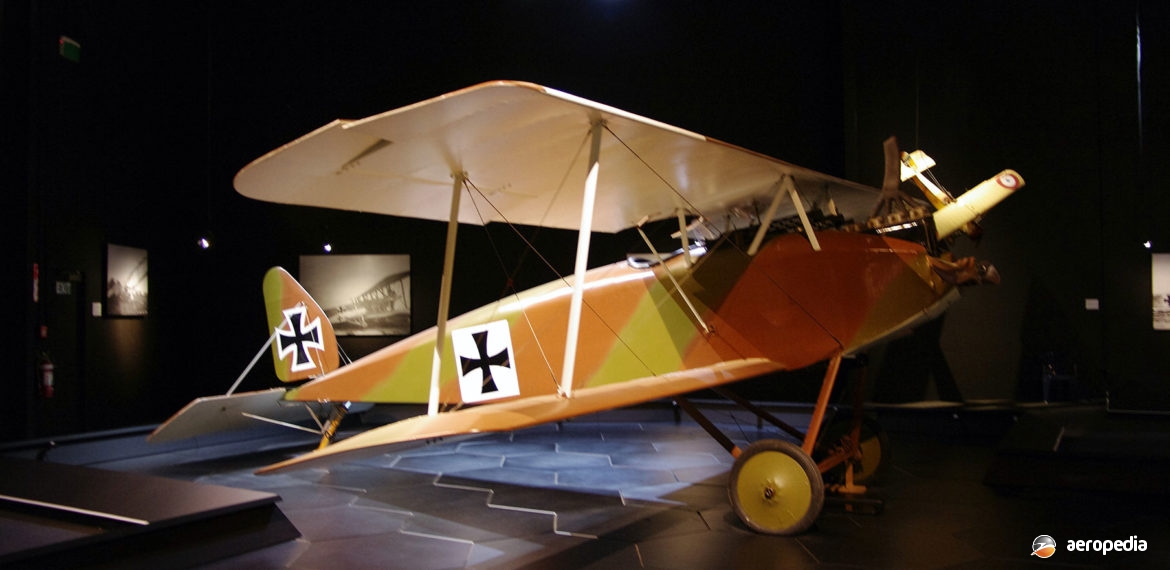Photograph:
Albatros C-series replica in the Omaka Aviation Heritage Centre near Blenheim, New Zealand (David C Eyre)
Country of origin:
Germany
Description:
Two-seat reconnaissance biplane
Power Plant:
One 119 kw (160 p) Mercedes D.III six-cylinder in-line liquid-cooled engine
Specifications:
- Wingspan: 12.90 m (42 ft 3⅞ in)
- Length: 7.85 m (25 ft 9 in)
- Wing area: 40.40 m² (434.9 sq ft)
- Max speed at sea level: 140 km/h (87 mph)
- Service ceiling: 3,000 m (9,845 ft)
- Endurance: 2 hrs 30 mins
- Loaded weight: 1,190 kg (2,624 lb)
Armament:
One 7.7 mm (0.303 in) Parabellum machine gun; bombs up to a max of 70 kg (154 lb)
History:
At the opening of hostilities in World War I the opposing forces mainly used aeroplanes for reconnaissance and observation of enemy movements and very little thought was given to offensive action. In 1915 Germany introduced the armed two-seat Albatros C-series type aircraft which had the most powerful engines available, but the observer was provided with a machine gun for defence and offence.
One of the first of the new types was the Albatros C.I which was basically similar to the Albatros B.II but was larger overall and had a Parabellum machine gun on a Scarff type ring. Initially powered by a 112 kw (150 hp) Benz Bz.III engine it offered a better field of view for the crew, but once placed in production it became a two-bay biplane with a 119 kw (160 hp) engine. It was a strong aircraft and was described as having good stability and flying qualities.
The Albatross C-series was used in substantial numbers both on the Western and Russian fronts, mainly for photographic and reconnaissance work. As operations continued it was used for bombing, being able to carry 70 kg (154 lb) of bombs stowed in a space between the cockpits. Both Oswald Boelcke and Manfred von Richthofen flew the C.I and this model could be distinguished by the radiators on each side of the cockpit. This model was placed in production by BFW and LFG with a radiator of the box-type on a wing leading-edge and this became the C.Ia. A dual-control version became the C.Ib in 1917 and was built by Merkur for training.
The C.III followed and was scaled up from the B.III having revised tail surfaces. It was the most widely built of the C-series and examples were built by Albatros, OAW, DFW, Hansa, Linke-Hofman, LVG and Siemens-Schuckert. The Parabellum machine gun was standard, but some C.IIIs had a forward firing Spandau machine gun on the engine block. It entered service in 1915 and saw service in Macedonia, Russia and the Western Front. For light bombing it could carry 90 kg (198 lb). The C.IV was introduced in 1916 and was basically a C.III with a new single-bay wing but only one was completed. The C.VI was the C.III with a 134 kw (180 hp) engine but only a few were completed.
The C.V series was designed by Mr Robert Thelen with Mr Schubert and was larger than the C.III, having a new cigar-shaped fuselage, fitted with the Mercedes D.IV engine which provided 164 kw (220 hp) and a flush mounted wing radiator. Some 424 examples were built, entering service in 1916, but the engines suffered crankshaft failures and this model was abandoned. The C.VII was introduced in 1916 for long-range reconnaissance and artillery observation and was fitted with a 149 kw (200 hp) Benz Bz.IV engine. It was built in large numbers and at one stage 350 were in service at the front.
In mid-1917 the C.X appeared and had wing mounted radiators, double ailerons and a number of other aerodynamic improvements. It was popular with crews and carried oxygen equipment as well as a wireless and light bombs. It remained in service until mid-1918 when the C.XI was to appear but this was only a project until the definitive C.XII appeared at the front. Final production C-series was the C.XIV which flew in prototype form in 1917 and went into production in 1918 but only a few had entered service when the Armistice was signed.
Examples of the C-series were captured by Australian troops and at least two examples were taken to No 2 Aircraft Salvage Depot in Britain as War Trophies. One serialled 4908/18 ended up at No 2 ASD but its ultimate fate is not known. One Albatross C.Ib was brought to Australia after the war. Built by Merkur Flugzeugwerke, it had a Mercedes engine but its serial is not known. It seems storage space was at a premium and the Queensland Government was offered the aircraft but refused to accept it as no suitable Government building was available where the machine could be safely accommodated.
This aircraft was offered to the Brisbane City Council, which accepted the machine, and it was conveyed to Queensland on board the ‘SS Parattah’ on 20 February 1922 for exhibition. It is believed to have been placed on display at New Farm but over time deteriorated. In 1930 an Albatros “German war souvenir plane” was located in New Farm Park, Brisbane. It was said to be in need of repair and was offered to various museums by the Brisbane City Council but no-one was interested. It was eventually broken up and only the gun ring has been preserved.
An Albatros C.VII was imported to New Zealand in 1919 after World War I for exhibition, being placed on display at the Canterbury Museum and remained there up to the 1930s. It seems it was put in storage for some years. Some reports say it was burnt in 1943. Eventually the remains were noted at Harewood in about 1950, having been dumped on the airfield boundary under some trees.

